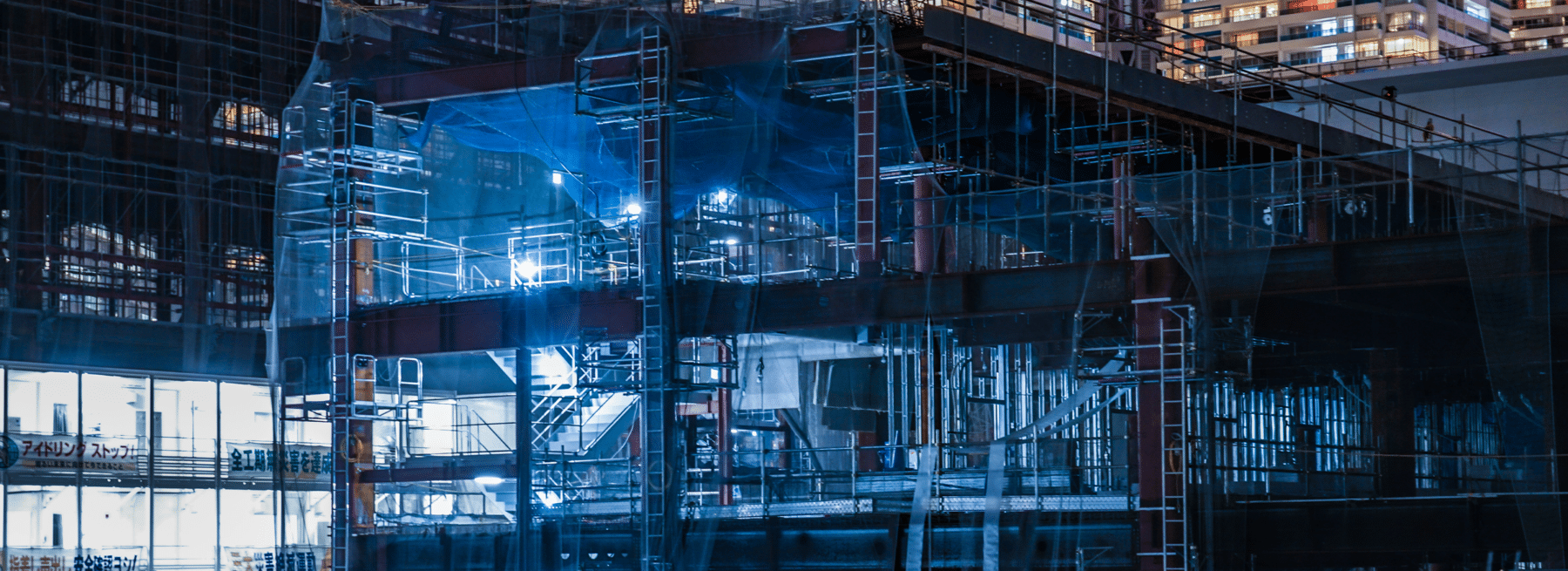One of the fastest, cheapest, and most effective options for construction site security and safety is lighting. Temporary lighting increases construction site safety and security while reducing the risk of injuries and fatalities.
How bad are the fatalities and injuries in construction? The industry has seen a huge drop in worker deaths from an average of 38 per day in 1970 to about 15 per day in 2019 as reported by the Occupational Safety and Health Administration. Unfortunately, OSHA says the construction industry still accounts for 20% of all worker fatalities in a year.
OSHA reports that 60% of the fatalities are due to the “Fatal Four” construction hazards. These include the following:
- Falls
- Struck by an object
- Caught between equipment or objects
- Electrocution
Construction sites that take steps to eliminate these four will save many lives. It’s not just the fatalities that are a concern for construction companies. Every day injuries occur at a much higher rate. These numbers are better than they were in the 1970s, but there is room for improvement as 3 out of 100 workers had an injury in 2019. This covers only the reported injuries.
A notable 25% of construction workers say they won’t report their injuries according to a survey from the National Safety Council reports that occupations in construction are one of the top five industries with the largest number of injuries. It’s challenging to make sure the construction project stays on schedule between the shortage of qualified construction workers and finding replacements. All that said, it’s critical to look for ways to reduce construction site deaths and injuries.
You can do many things to improve safety and lower injuries. Lighting is one of them. However, construction site lighting is a science that requires strategy and planning. There are factors to consider such as what kind of lighting, how much lighting, and where to place the lights.
Lighting Standards for Construction Sites
OSHA standard 29 CFR 1926.56 contains the minimum requirements on lighting for construction sites as it states the following.
“Construction areas, ramps, runways, corridors, offices, shops, and storage areas shall be lighted to not less than the minimum illumination intensities listed in Table D-3 while any work is in progress.”
OSHA also considers industrial lighting standards and recommendations from other agencies such as American National Standards Institute (ANSI). The original practice for industrial lighting from American National Standard A11.1-1965, R1970 contains recommended values of illumination.
A letter from OSHA‘s Directorate of Compliance Programs states this standard is “a nationally-recognized consensus standard cited by reference under paragraph 1910.261 of Part 1910-Safety and Health Regulations For General Industry and under paragraph 1926.56 of Part 1926-Safety and Health Regulations For Construction. This ANS standard was developed with the active collaboration of the Illuminating Engineering Society (IES), now identified as the Illuminating Engineering Society of North America (IESNA). OSHA recommends that employers use this standard as guidelines to determine sufficient lighting required to provide for the safety and health of employees in workplaces.”
OSHA standard 1926.56(a) only provides minimum illumination requirements for a construction site. Your construction site might also have more stringent occupational safety requirements for exterior lighting. So, check the regulations for your state.
Types of Lighting for Construction Sites
Even with the standards, the ideal lighting solution varies for every construction site. These are some of the types of lighting often used on construction sites. The best way to ensure to optimize your lighting is by working with a security expert. They will help you get exactly what you need without overspending.
Portable light towers
The most common lighting on construction sites is the portable light tower. These are the tall lights that can be on a tripod or on wheels to make it easier to move them. They may be as high as 30 feet and have the ability to rotate 360 degrees. Towers come in different options such as one giant light, two lights, or four lights. They cast light over a wider area than equipment-mounted lights or side lighting kits can. They increase visibility and prevent shadows on a construction site.
Some are now solar-powered and can last up to 36 hours. Some are battery-powered or use gas or diesel. It would be better to opt for power light towers that run on solar or battery because it will improve air quality and reduce noise pollution. The fewer emissions used on a construction site, the healthier the air quality will be for everyone on the site.
Balloon lights
Balloon lights have helium- or air-inflated covers that light up large areas with diffused light. This eliminates glare and shadows to make it safer to work at night. Balloon lights can be on a mobile cart or a lightweight tripod. Their compact size and simplicity allow them to be quickly deployed and portable. They can be mounted onto equipment or vehicles and run on electricity, which improves air quality and lowers emissions.
These can be used with environment-friendly light-emitting diode (LED) bulbs to enhance illumination and sustainability. LED bulbs last about 10 times longer because they’re more energy-efficient than traditional incandescent lights. Any effort to reduce emissions and improve air quality lowers the amount of air pollutants inhaled by construction employees and helps keep them healthy.
High mast lights
Less common than portable light towers, high mast lights use a light pole that can be 100 feet tall. The light pole supports a luminaire ring with four to eight lights. However, they’re not as portable as the other options because they’re semi-permanent.
Equipment-mounted lights
These lights can be mounted to heavy machines to increase visibility. Many of these machines and equipment have small headlights that don’t provide sufficient lighting. They can be mounted to stationary items for more ground-level lighting.
Sustainable Lights Delivering Cost Savings
If possible, trade compact fluorescent light (CFL) and incandescent bulbs for LEDs, which last longer and are more sustainable making them better for the environment. Oftentimes, non-LED lighting only lasts for the duration of the project and gets trashed at the end of a project.
LEDs have an 80 percent lower rate of consumption compared to traditional lighting. They can be reused and can last five years. One LED light has the same amount of coverage as a 250-foot stretch of string lights. They deliver aggregate savings worth thousands of dollars. Switching from stringed lights and other inefficient lighting saves hours of labor and associated costs.
Additionally, construction sites can find more savings by using lighting systems that run on solar or battery power. Lighting that uses gas or diesel contains emissions and pollutes the air. This puts workers at risk for breathing problems and lung-related illnesses.
Choosing the Right Type of Lighting
Many people aren’t aware that brighter lighting is not always better. Few know how the importance of color and hue makes a difference to visibility. It’s critical to avoid using lighting that causes glare problems and hurts workers’ eyes. That’s why it’s recommended that you work with a security expert who has experience in lighting. They will help you figure out what types of lights you need, how many lights you need, and where to place them.
Don’t forget to add lighting in other areas such as the parking lot and the walkway between parking and the construction site.
Lighting does more than help worker safety. It also boosts security. A Propmodo story says that the most common cause of theft on construction sites is due to “security negligence.” This means they have insufficient lighting and poor construction site security.
In addition to lighting, you can enhance construction site security with remote video surveillance that includes video analytics and trained monitoring operators. The operators are not on the construction site. They monitor the site from another location.
A lot happens on a construction site. It’s hard to watch over it all with the many security and safety challenges. Implementing effective lighting and video surveillance can help protect your workers and your assets. The security camera system records and saves everything.
To learn more about construction site security, get your free copy of the construction security and safety best practices guide. This guide looks at the industry challenges and provides solutions. If you’d like to know more, feel free to contact us.

